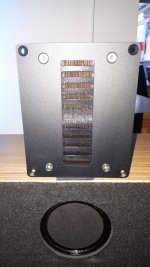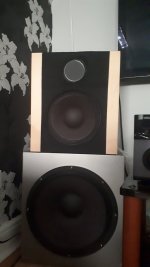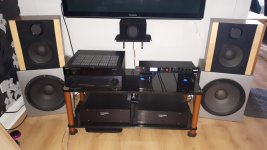Since I first read about BMR drivers I found the idea quite interesting.
Once I found out about f.e. NAIM using them and the Philharmonic BMR speakers I decided I wanted to try them.
But - besides having built 3 or 4 designs by other people, I have zero knowledge about speaker design, I know diddly squat about electronics - I'm a software guy, not a hardware / electronics guy...
So anyway, I ordered a pair of Tectonic TEBM46C20N-4B BMR 3" Full-Range drivers (because I think that's what the Philharmonic BMR's use?).
I'm testing them right now in a test-cabinet together with a woofer and a tweeter.
They sound good - I like their dispersion, good sound off-axis.
But - when disconnecting the woofer and the tweeter, and turning up the volume a bit, to me it really does sound like overdriven (distorted) sound from a boombox.
I mean, it's a 3" driver so what can you expect, right?
But on the other hand I see very expensive speakers / speaker kits using these drivers - or drivers like these - and getting amazing reviews (like the Philharmonic BMR).
I know it's not them, it's me - I'm just starting out with audio stuff so what do I know.
But can anyone explain to me how for example the Philharmonic BMR speaker either gets great reviews while the mid-range driver (the small BMR) distorts so much when turning up the volume... OR how they avoid the mid-range (BMR) driver distorting somehow when turning up the volume?
(I'm not talking about club-level volume, I'mt talking about "birthday party" volume.. just slightly more than "usual living room volume" 🙂)
Once I found out about f.e. NAIM using them and the Philharmonic BMR speakers I decided I wanted to try them.
But - besides having built 3 or 4 designs by other people, I have zero knowledge about speaker design, I know diddly squat about electronics - I'm a software guy, not a hardware / electronics guy...
So anyway, I ordered a pair of Tectonic TEBM46C20N-4B BMR 3" Full-Range drivers (because I think that's what the Philharmonic BMR's use?).
I'm testing them right now in a test-cabinet together with a woofer and a tweeter.
They sound good - I like their dispersion, good sound off-axis.
But - when disconnecting the woofer and the tweeter, and turning up the volume a bit, to me it really does sound like overdriven (distorted) sound from a boombox.
I mean, it's a 3" driver so what can you expect, right?
But on the other hand I see very expensive speakers / speaker kits using these drivers - or drivers like these - and getting amazing reviews (like the Philharmonic BMR).
I know it's not them, it's me - I'm just starting out with audio stuff so what do I know.
But can anyone explain to me how for example the Philharmonic BMR speaker either gets great reviews while the mid-range driver (the small BMR) distorts so much when turning up the volume... OR how they avoid the mid-range (BMR) driver distorting somehow when turning up the volume?
(I'm not talking about club-level volume, I'mt talking about "birthday party" volume.. just slightly more than "usual living room volume" 🙂)
Is this a specific constraint for the mentioned Tectonic driver?For low distortion, crossover should be at least second-order high-pass at 500 Hz or higher.
Or is this constraint based on f.e. the diameter of the BMR driver meaning it would also apply to other brands of BMR drivers.. or is it based on other parameters?
Edit:
I googled a bit to find out the lo-mid crossover for the Philharmonic BMR speaker, couldn't find anything conclusive but some posts hinted at the crossover being between 550Hz - 700Hz
Cheers for pointing me in the right direction, I'll be doing some more Googling 😛
Last edited:
When you were listening to just the Tectonic driver, were you literally running it full range including bass and high frequencies? If so, that is likely why it was distorting. Because Dennis (of Philharmonic Audio) liked the Tectonic so much, I also used it in one of my personal builds for a 3-way, the Balmora, crossing from the woofer at 480 Hz (asymmetrical slopes) to the Tectonic, then from their at 3800 Hz to the tweeter( LR2 slope). I will attempt to attach a 1-page Highlights for the Balmora, but it may be too large.
Paul
Paul
Attachments
Yes, from distortion measurements:Is this a specific constraint for the mentioned Tectonic driver?
https://hificompass.com/en/speakers/measurements/tectonic/tectonic-tebm46c20n-4b
I was using a 200Hz highpass and a 7000Hz lowpass filter.When you were listening to just the Tectonic driver, were you literally running it full range including bass and high frequencies?
But now I've learned I should up that to at least 500Hz 🙂
Cheers!!
Over the years I've bought a bunch of BMR and RED (Rapid Energy Decay) full range drivers and various speakers / cabinets and tried loads of configurations... Done right they can sound really great, but in my experience they need an active crossover / DSP and Eq to get them to sing. At the end of the day they are no "silver bullet" just another variation on a small paper coned broad range driver... There is no 3, 4 or 5 inch driver on the planet that can go loud with low distortion from 80Hz to 20Khz...I was using a 200Hz highpass and a 7000Hz lowpass filter.
But now I've learned I should up that to at least 500Hz 🙂
Cheers!!
I use the Beyma TPL 200 S as my reference top end (its AMAZING above 1,800Hz!) and no BMR gets close... Sorry!
Over the 400Hz to around 4Khz the RED driver is great, the 4.5 inch BMR with NEO magnet is good.
They all distort below 200Hz ish at realistic SPL's.
None of them have the dynamic range/ power handling to compete with a good 5 or 6 inch Pro mid.... I use the Beyma 10 MC 500 from 400Hz to around 1,800 Hz or a PHL 1120 (400Hz to 2 Khz) as my reference.
I have attached a few pics might be of interest...Hope they help?
Cheers
Alex.
Attachments
I am not familiar with RED drivers - what are they? Where they are available?Over the years I've bought a bunch of BMR and RED (Rapid Energy Decay) full range drivers
I dont think the RED drivers are in production anymore. I bought three pairs along with a bunch of other kit from Derek Wilson (Overkill Audio) about 2 years ago.
In about every driver I have measured, distortion skyrockets at about 1/2 of X-Max. So as an SOP, I put the TS parameters into WinISD and model it as a woofer, then see how much power it takes for the desired SPL and look at the excursion to see where the corner is. Add filters and tweak. I find, it is usually somewhere around 3 times the Fs, but it varies.Yes, from distortion measurements:
https://hificompass.com/en/speakers/measurements/tectonic/tectonic-tebm46c20n-4b
Still don't have an idea what RED drivers are. Any link (or photos) to the actual drivers or loudspeakers? It doesn't matter if they are available now or not, I am just curious what they are, never heard of them. Manger drivers were used in some models of Overkill Audio, but Manger driver was never advertised as "Rapid Energy Decay (RED)" driver.I dont think the RED drivers are in production anymore. I bought three pairs along with a bunch of other kit from Derek Wilson (Overkill Audio) about 2 years ago.
Last edited:
The pictures I posted show a 4,5 inch (70 Sd) RED driver, its the one above the 10 inch bass/mid. It looks smaller because the driver frame is covered with baffle felt.
Basically the differences between BMR and RED are:
Cones - RED drivers use a lighter but stiffer carbon fibre honeycomb structure in between the two flat paper layers The BMR uses all paper honeycomb and front/rear cone fac.
Surround - RED drivers use s are a silk/cotton material (thats my guess!) with a coating of some sort. The BMR uses standard rubber surround.
RED driver uses a bigger diameter voice coil, approx 38mm. Not sure what the BMR uses.
RED uses a very stiff spider. The cone on the RED driver has a much stiffer overall suspension.
Cant remember all the TS parameters but the RED has higher FS, lower Qts lower CMS (stiffer suspension) and pretty much all other TS were different from BMR.
The whole idea was to minimise time domain distortion ie have the best step response and shortest settling time on the 3D CSD plots.
It certainly sounds great compared to the BMR... But as a midrange unit in the 400Hz to 2KHz band the PHL 1120 is way better.
Basically the differences between BMR and RED are:
Cones - RED drivers use a lighter but stiffer carbon fibre honeycomb structure in between the two flat paper layers The BMR uses all paper honeycomb and front/rear cone fac.
Surround - RED drivers use s are a silk/cotton material (thats my guess!) with a coating of some sort. The BMR uses standard rubber surround.
RED driver uses a bigger diameter voice coil, approx 38mm. Not sure what the BMR uses.
RED uses a very stiff spider. The cone on the RED driver has a much stiffer overall suspension.
Cant remember all the TS parameters but the RED has higher FS, lower Qts lower CMS (stiffer suspension) and pretty much all other TS were different from BMR.
The whole idea was to minimise time domain distortion ie have the best step response and shortest settling time on the 3D CSD plots.
It certainly sounds great compared to the BMR... But as a midrange unit in the 400Hz to 2KHz band the PHL 1120 is way better.
Last edited:
- Home
- Loudspeakers
- Multi-Way
- Question about 4" BMR drivers like used in Philharmonic's BMR kit... (F.E. Tectonic, or Cotswold Audio)




